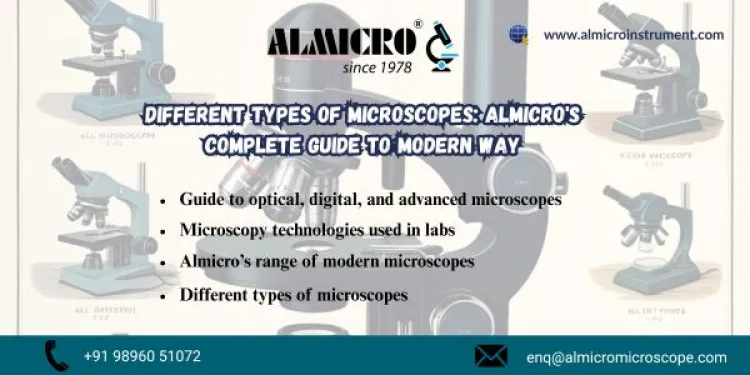
Different Types of Microscopes: Almicro's Complete Guide to Modern Way
Microscopy has revolutionized the way we view the world around us. There are currently several different microscopes with various properties, all of which have been developed for certain scientific, educational, or industrial applications. You are a student, scientist, or enthusiast; details about various types of microscopes can assist you in choosing the right tool for your work. Well-known companies such as Almicro provide a series of good-quality microscopes for specific uses.
Types of Microscopes Currently Available
The major categories of microscopes include light microscopes, electron microscopes, digital microscopes, and industry microscopes. Medical microscopes, for example, are found in hospitals to perform pathology, while toolmakers' microscopes play an essential role in precision engineering for the observation of extremely small mechanical parts. Almicro sells generic and special models for applications in particular industries.
Types of Microscopes for Specialized Applications
Coming to the kinds of microscopes, we have educational models, clinical diagnosis, research results, and industrial quality checks. ISI-marked microscopes are one of the commonly used examples, which maintain high-quality standards and are dependable in government and private labs across India. Almicro ensures that all their ISI-marked models are high on optical clarity and durability.
Types of Optical Instruments: Light Microscope Types
When optical instrument categories are under comparison, light microscopes are the most discussed. General light microscope types are the compound microscope, most appropriate for cellular studies, and the stereo microscope, most appropriate for dissecting and observing larger specimens with a three-dimensional perspective. For use in schools, the student microscope that is produced by Almicro is most appropriate in making science come alive among kids.
Microscope Models in Electron Microscopy
In electron microscopy, some models like the Scanning Electron Microscope (SEM) and Transmission Electron Microscope (TEM) are widely used. These electron microscope models are ultra-high-resolution and enable scientists to observe even viruses and nanoparticles, and are thus crucial in high-end research work. Almicro offers consultancy to laboratories that plan to have high-end microscopy facilities.
Details about Microscope Classifications for Students
Choosing the right microscope can be overwhelming, especially for students. In schools, the most frequently used categories of microscopes are student microscopes, easy to operate and long-lasting. Almicro student microscopes are carefully crafted with maximum attention to facilitate hands-on learning without any compromise on quality.
Microscope Technologies: The Rise of Digital Microscopes
Today's microscopy technology has come up with effective digital microscopes that combine optics with high-definition cameras. A USB microscope or camera microscope enables one to project images larger than life onto a monitor, which is easy to review and share findings. The majority of research microscopes sold at Almicro are equipped with advanced digital features that are easy to use.
Microscopy Types: Advanced Techniques for Professionals
As science requires more, so do methods of microscopy. Fluorescence, confocal, and atomic force microscopy are advanced microscopy methods that allow researchers to examine delicate cellular structures, living cells, and even forces at the molecular level. Multi-head microscopes like Penta Head and Deca Head microscopes, offered for sale from Almicro, also allow multiple users to examine the same specimen simultaneously — a convenient setup for teaching hospitals and cooperative research.
Imaging Equipment for Industrial Research
Indusrial microscopes, together with other imaging equipment, form a crucial component of research labs. Scientists have come to trust lab microscopes and research microscopes to see anything from reactions between chemicals to tissue samples with unyielding accuracy. Multi-head models are a favorite with institutions that perform high-level research, and Almicro offers an entire gamut of solutions cut to suit such collaborative environments.
Conclusion: Choosing Proper Magnification Equipment
All science or education professionals must be familiar with the various magnification equipment available today. There are just so many varieties of microscopes, each with varying purposes — from student microscopes to medical microscopes to sophisticated toolmakers' microscopes — and the right choice guarantees quality output and improved comprehension of the microscopic world. For reliability and innovation, some professionals and institutions choose Almicro for their microscopy requirements.
